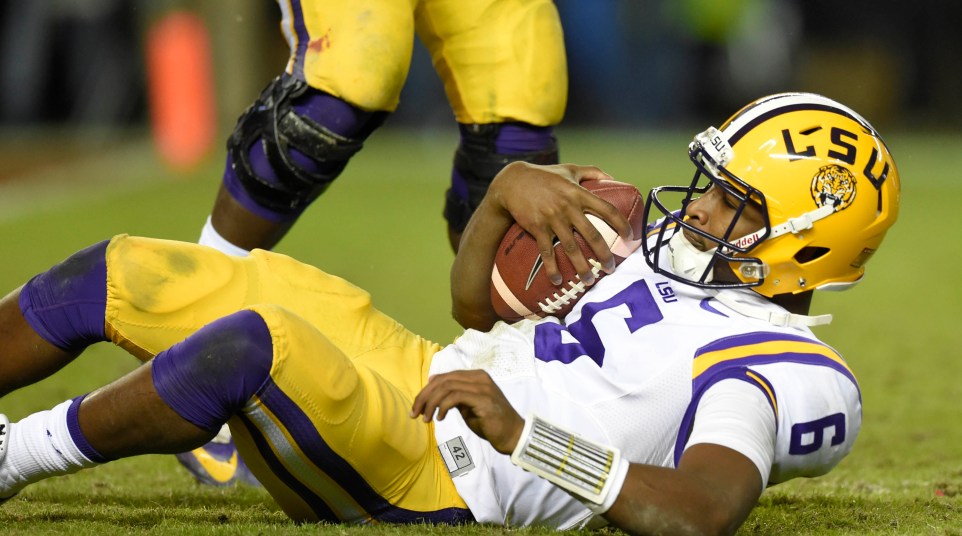
Why LSU struggled so much on third down -- and how it can do better in 2016
With Leonard Fournette running wild, the LSU offense often moved the chains with ease last season. But even with their star running back picking up yards in bunches, the Tigers still found themselves facing third-and-long situations.
And it didn’t always end well.
Overall, LSU ranked 59th nationally in third-down conversion rate in 2015. The team converted 39.86 percent of its opportunities, just behind Boise State (39.9) and ahead of Middle Tennessee (39.78).
Although the Tigers managed to win games even when they didn’t convert on third down — LSU converted just 1 of 6 while rolling Eastern Michigan, 44-22 — its struggles impacted several SEC games.
Sure, the Tigers completed 47 percent of their third downs against Alabama. But that wasn’t enough to prevent the Crimson Tide from dishing out a 30-16 loss.
LSU’s struggles continued the next two weeks, as it converted 43 percent against Arkansas and 28 percent against Ole Miss. The Tigers lost both games by two touchdowns or more.
It was a problem.
The LSU offense routinely found itself in difficult situations during its three-game losing skid.
Against the Tide and Razorbacks, the Tigers needed to gain 10 yards or more on 12 of the 25 third downs they faced. That trend continued against the Rebels, as LSU needed to gain 7 yards or more on 9 of 18 third downs it encountered.
Through the first three quarters, the offense had a difficult time converting. It wasn’t until the fourth quarter, when quarterback Brandon Harris connected with John Diarse for a 12-yard gain on a 3rd-and-10, that they finally moved the chains.
LSU only converted twice when the marker was 7 or more yards away. Interestingly, the other 3rd-and-long conversion came when Harris ran for 21 yards on a 3rd-and-10 later in the final quarter.
While Harris made something out of nothing on that play, the Tigers rarely converted 3rd-and-long situations when they opted to run the ball. That isn’t to suggest it never worked — Harris ran for a first down on 3rd-and-11 against Mississippi State and another on a 3rd-and-7 versus Auburn.
However, examples of the run game working on vital 3rd-and-longs are scarce. And the passing game gained just 19 first downs all season on 61 pass plays that started 3rd-and-7 or longer.
It wasn’t always by design, but Harris routinely attempted to scamper for first downs when defenses locked up his receivers. Earlier in the season, at Mississippi State, Harris tried to run for a first down on 3rd-and-21.
Harris rolled to the sideline for a 5-yard gain.
Behind the chains is no place to be, but last season wasn’t the first time LSU struggled on third-and-long. In 2014, LSU ranked 81st nationally after converting 37.95 percent of third downs.
This season, the team will hope to find the magic formula it had in 2013, when they led the nation with a 56.49 percent conversion rate.
Part of the problem in recent years has been penalties sending the offense in reverse.
LSU ranked 121st nationally after averaging eight penalties per game. That number jumped up considerably from the 5.4 penalties the Tigers averaged in 2014.
But with three starters — Ethan Pocic, Will Clapp and Maea Teuhema — returning to the line, penalties shouldn’t be as big of a problem this season. Limiting flags is the first ingredient in the recipe of success for the Tigers, who will try to remain in their comfort zone and let Fournette thrive in third-and-short situations.
LSU run 34 times last season on 3rd-and-6 or fewer and gained a first down 18 times.
There will still be times when the offense is called upon to succeed on 3rd-and-long, of course, though LSU fans should be optimistic 2016 will be more reminiscent to 2014.
Harris has the tools to throw the ball around, and with Malachi Dupre and a healthy Travin Dural leading the receiving corps, those situations shouldn’t cause the headaches that plagued the Tigers last season.
